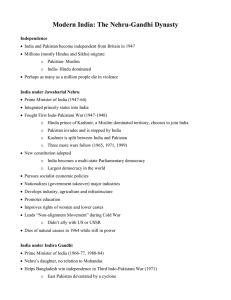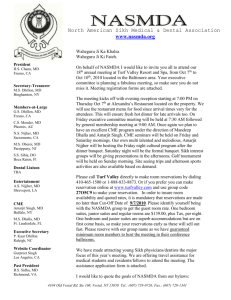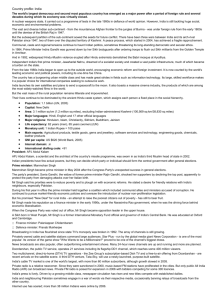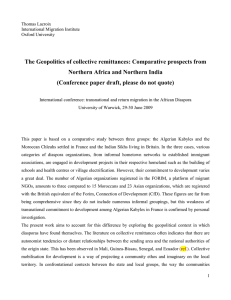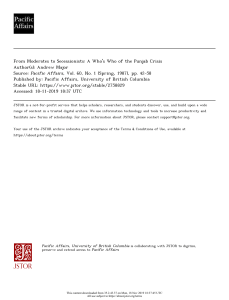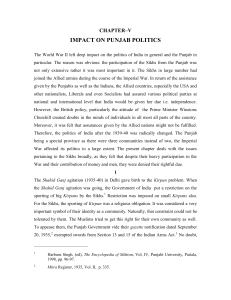Janata Party and After
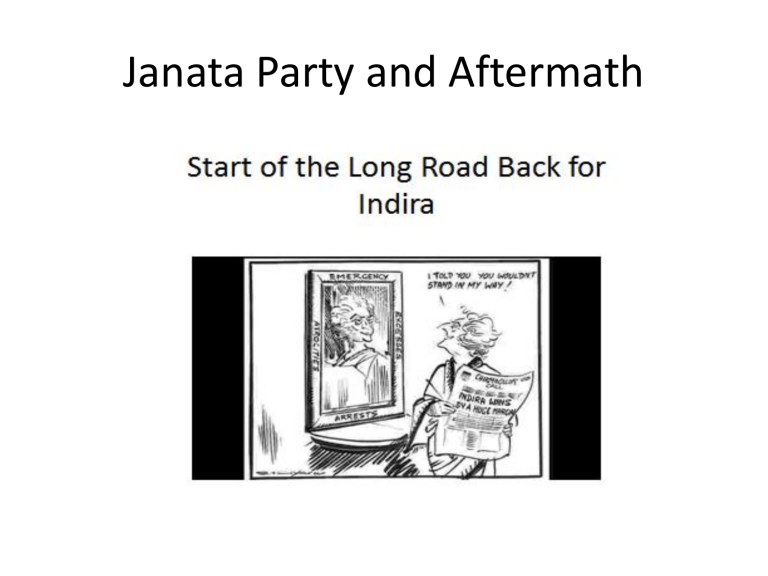
Janata Party and Aftermath
Significance of Janata Era
• The era crystallized some important emerging
TRENDS in contemporary India which only now were allowed a POLITICAL expression.
• The overwhelming presence of the INC since independence MASKED significant social and economic changes in the.
• Ironically, the divided, bickering, uncohesive
Janata Party allowed expression to these changed realities.
• Janata Party did not last, but these new trends remain a significant aspect of Indian politics
Middle Peasants
• British agrarian policies on the 20thC gave lower caste
CULTIVATORS of land a lot more rights than traditionally had.
• ABOLITION of ZAMINDARI benefited similar CULTIVATING groups.
• Many of these groups had been the backbone of Nehru’s lieutenants such as Kamaraj. They then came to support parties such as DMK in Tamilnadu, were the backbone of the
CPM in Bengal.
• Where the GREEN REVOLUTION was successful, the folks who really benefited most were the middle peasants/ cultivators
• Indira’s populism work to their benefit. Erase debts of electricity e.g.
• Middle peasants gaining clout in states for a while, especially in UP, Punjab, Bihar, Bengal as well as TN, Andhra Pradesh.
Other Backward Castes (OBC)
• Now these groups coalesce around the label of OBC
• No classical text had this notion of BACKWARD or FORWARD Castes
• A product of modern politics: folk who felt themselves to be dispossessed.
• Commission of Enquiry (Mandal Commission) set up by JANATA
Government pointed out the relative disadvantage in terms of jobs, education, etc. of OBCs
• In the Forward category were the Brahmins, the Rajputs (aka Kshatriya)
Kayastha and Bania (Vaisya) who had “historically monopolized literacy, scholarship, commerce, and political power” (Guha, 530) to which must be added, historically, control over LAND.
• But, Dalit and OBC together formed well over 60% of the population.
• They were the real CULTIVATORS, leased land or small owners. In turn
OBC employed other, LOWEST caste, often DALIT LABORERS in the farms they cultivated
Other Long Term Impacts of Janata Era
• DECENTRALIZATION of Indian politics
• Greater autonomy of States (especially as compared to Indira Gandhi’s era)
• Emergency spawned many new social
movements, civil society, civil liberties, feminists, etc. Censorship led to revival of interest in Journalism!!
Indira Second Innings
Second Innings
• Sanjay death
• Mrs Gandhi’s reliance on family increases.
Rajiv Gandhi pushed into politics
• Populism and Autocracy
• States’ Rights and States Pride : NTR in
Andhra Pradesh, AASU in Assam, and
Separatism in PUNJAB
• Populist Communalism in KASHMIR
Kashmir
• BEGIN COMMUNALIZING the situation in
Kashmir.
• In 1983 Farookh Abdullah, Sheikh’s son joins an opposition coalition
• Mrs G in her campaign painted him as a secessionist.
• BLATANTLY appealed to HINDUS of Jammu, and invoked FEAR of VALLEY MUSLIMS.
• Farooq won, but this event first created
RELIGIOUS polarization in Kashmir
• Even separatists , TILL THAT TIME had spoken of need to secede because they were KASHMIRI and included Hindu Kashmiris in their description of Kashmir. This was to change soon after.
PUNJAB and Sikhism
• SIKHISM: 15-16 th C, founder Guru NANAK
• Given present form by Guru Gobind 17th C
• 18-19th C RANJIT SINGH Sikh kingdom
• 19th C reformers, SINGH SABHAS
• Early 20 th C AKALI DAL
• 1947 Tara Singh demand for separate Sikh homeland. Dismissed
• 1966 Punjab as Linguistic State
Political Context of 1980s
• Akali Dal vs INC main rivalry
• Rough parallels to Sikh and Hindu pop.
• Green Revolution makes many Sikh middle peasants richer
• Indira Gandhi tries to break the hold of Akalis by promoting an extremist Sikh religious leader Jarnail Singh BHINDRANWALE
BHINDRANWALE
Out of Control in Punjab
• Political Assassinations
• Civilian Massacres
• Targeted Killings police and military personnel
• Take over and fortify the Golden Temple in
Amritsar
Operation Blue Star and
Assassination
• Army Called in
• Parts of temple destroyed in seige (use of mortars deemed necessary)
• Bhindranwale and followers killed
• Anger at desecration
• Mrs Gandhi assassinated by Sikh bodyguards in 1984
• Anti Sikh pogroms in in Delhi and other cities
Dynasty Established: The Other Son
• RAJIV GANDHI
• Elections following assassination lead to LARGEST EVER MANDATE
• Seen as fresh, new, honest, and
NOT a traditional politician.
Immense hopes, quickly belied!!
• Began well, two quick accords with regionalists, ASSAM MIZO and
PUNJAB.
Rajiv’s Populism
• INC Reforms don’t work out
• BABRI MASJID
• Shah Bano Case
• Then, BOFORS, Corruption Accusations
• VP Singh
Economic Liberalization
• Starts under Rajiv and VP Singh is his finance minister
• But after promising start, does not deliver in the dismantling of the “license-raj”
• PV Narasimha Rao 1991 crisis
• Manmohan Singh as Finance Minister
• BJP ambivalence “Swadeshi” on the one hand and “Pro-Business” on the other
CONTEXT
• Soviet Union collapse, valuable trade partner. India e.g. barter foodstuff for oil with USSR for a long time. NO loss of foreign exchange.
• IDEOLOGICALLY big blow to planned economics, state control of economies, and immense and perhaps unjustifiable faith in the market replace that.
• Attack from international economists, often expatriate Indian =
State controls of the economy had led to stagnation, lack of competition, lack of growth. Jagdish BHAGWATI (now at Columbia
University) of the major spokesmen for a NEW IDEOLOGY asking for removal of state control, free market and free enterprise, opening up of the barriers to international trade , as only solutions.
• Some change needed, no doubt, and governments, since Rajiv era. tempered by DEMOCRATIC politics, introduced market oriented reforms, slowly.
Questions About Growth
• Growth for WHOM? HOW will it solve the problem of illiteracy, inquality, etc. Would it simply make the rich even richer?
• Liberalization, market forces work to “growth” but as Edward Abbey said, “growth for the sake of growth is the ideology of the cancer cell!!”
• Rather than just “growth” need to focus on what KIND of growth, WHO grows and who doesn’t
• Ultimately though it come back to the central paradox. How will can one balance democracy with economic growth.
• WHY is this an issue in India?
• Paradox of a democracy, competing demands on state from different interests, often locally and parochially organized, at a time when there are not enough resources.
Achievements and Failures
• END FAMINE
• LIFE EXPECTANCE 30>60
• DEMOCRACY
• LARGE SCIENTIFIC COMMUNITY
• INDUSTRIAL INFRASTRUCTURE
• NUCLEAR & SPACE PROGRAMS
• POCKETS OF ECONOMIC
GROWTH
• WORLD’S LARGEST MIDDLE CLASS
• LOW FOOD AVAILABILITY: 35% LIVE
BELOW POVERTY LINE = ONE SQUARE
MEAL A DAY
• STILL WELL BELOW CHINA
• DALIT, POOR, WOMEN OFTEN DENIED
RIGHT TO VOTE
• WIDESPREAD ILLITERACY, 50% ADULT
LITERACY RATE
• LARGE NUMBERS LEFT OUT OF
DEVELOPMENTAL PROCESS
• LACK OF BASIC EDUCATION, UNIVERSAL
HEALTH CARE, ACCESS TO CLEAN WATER
• REGIONAL IMBALANCES
• SOME OF THE WORLD’S POOREST
